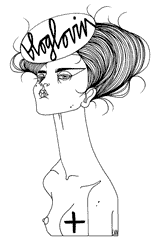"Here is a book for children who want to know "How, why, where and when?" It tells about some of the great inventions which have helpded to make the modern world."
For each of these great inventions Ladybird uses clear and simple language to describe it's story and significance. Great Inventions is a celebration of human endeavour and the drive for technological advancement.
The first invention mentioned is, appropriately enough, the printing press; "This book is printed. Thousands of children have a copy, and the words and pictures in each are exactly the same." It explains a little of the history and leaves children with the open ended question; "If you think for a moment, you will understand what a tremendous difference the invention of printing has made to the world." In this age of the internet I think it is easy to forget that the printing press, the books, newspapers and pamphlets that it creates, has done it once before. Connecting people, spreading ideas and information; it's all old news.
In recognition of this first invention I should also mention the book design. Great Inventions is one of those beautiful ladybird books with a full colour dust jacket illustrated with The magic eye of Radar. Underneath is a buff coloured hard back book with a line drawing of the front cover picked out in navy. Printed on the inside cover is a pattern created using the repetition of ladybirds with opened wings; beautiful.

Along with the printing press the other great aids to mass communication, the wireless telegraph, telephone, camera and television are also included in Great Inventions. As I used to work for the BBC, and early in my career worked on a few outside broadcasts for BBC Sport, I rather love the picture of an OB unit at work depicted here.
Amongst other great inventions mentioned are; the internal combustion engine and electricity. Of course, anything that sets itself up as a list of merit inevitably opens itself for debate. I notice that steam power gets four mentions; in the steam engine, railway engine, steamship and steam turbine. I think this could be a rather British bias, based on it's development by the British duo Watt and Boulton, it's importance to Britain's industrial revolution and our former British Empire.
Along with communication, transportation is also highly valued in this list (another legacy of empire?) with; the railway engine, steamship, bicycle, motor car, diesel engine, aeroplane, and jet engine, all getting a mention, along with the telescope, sextant and chronometer, pneumatic tyre and radar, all facilitators of transportation.
I'm surprised but gratified to see spinning and weaving and the sewing machine are included as great inventions. This pleasure is based purely on my own interest in textiles and love of making things in fabric. I would guess it's inclusion has more to do with the importance of cloth manufacturing in British industrial history. In the story of the sewing machine is the only mention of the negative impact of the drive for technological on the lives of people. In 1840 an "ignorant mob" attacked Thimonnier's sewing machines (and the inventor himself), which they believed would put them out of work. The destroyers of this great invention were French, so I guess that explains that in the eyes of the writer!
The Davy Safety Lamp is possibly the only thing listed in Great Inventions that would probably be immediately dismissed from any modern list of great inventions. Despite it's use in mines which; "prevented accidents and saved countless lives." The biggest omission I notice is the lack of any inventions in the sphere of health and biology.
So, communication, movement, dynamism and production are highly regarded in this list. Ladybird's list of great inventions is indicative of the 1960's British society in which it was written and it reflects. So, no surprises, it's final story is of Atomic Energy "a miraculous new source of power which heralds a new era - the Atomic Age."
This post is part of Ladybird Tuesday started on the Being Mrs C blog, take a look at her posts here.
I missed that we were joined last week by vintagemummy, so see her post on Talkabout Shopping here
And the rest of Mrs Fox's Ladybird Tuesday posts are here and if you have a collection of Ladybird books, please do feel free to join in.




























gosh, I think I had that book once upon a time...
ReplyDeleteI am watching "The Genius of Invention" on BBC 2, they have obviously pinched the whole show from Ladybird's Great Inventions book from 1969.
ReplyDelete